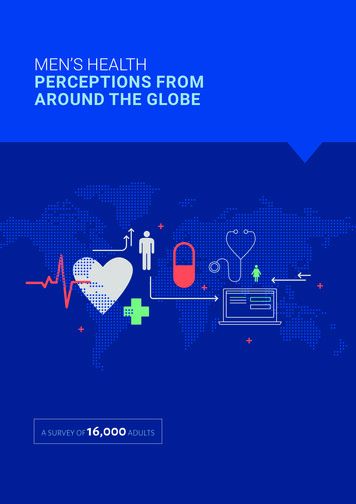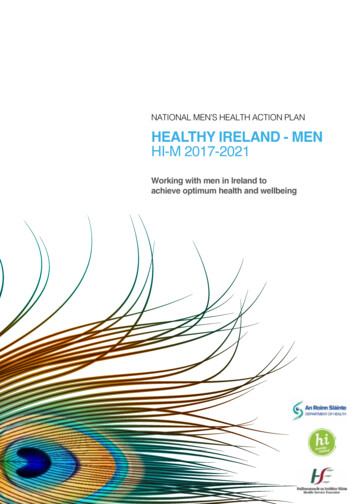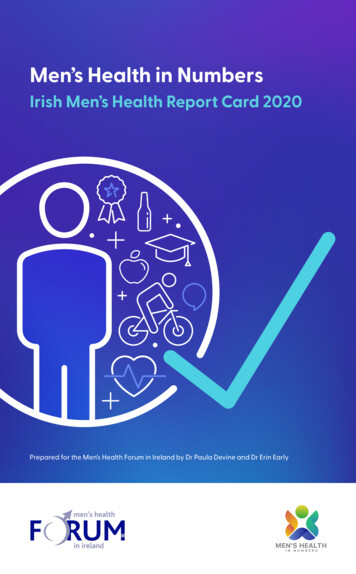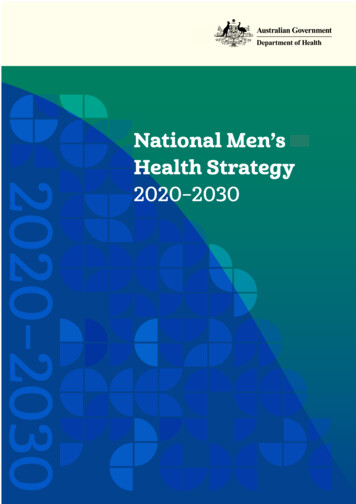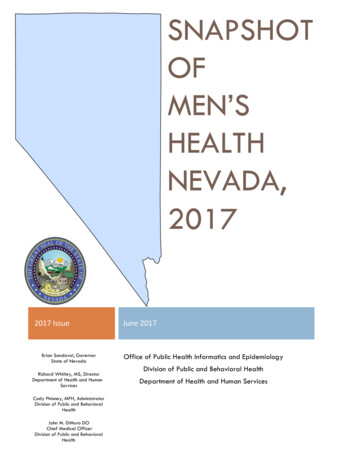
Transcription
SNAPSHOTOFMEN’SHEALTHNEVADA,20172017 IssueBrian Sandoval, GovernorState of NevadaRichard Whitley, MS, DirectorDepartment of Health and HumanServicesCody Phinney, MPH, AdministratorDivision of Public and BehavioralHealthJohn M. DiMuro DOChief Medical OfficerDivision of Public and BehavioralHealthJune 2017Office of Public Health Informatics and EpidemiologyDivision of Public and Behavioral HealthDepartment of Health and Human Services
Snapshot of Men’s HealthTable of ContentsSnapshot of Men’s Health . 3Purpose . 3Data Sources . 3Technical Notes . 4OVERVIEW OF MEN’S HEALTH IN NEVADA . 4LEADING CAUSE OF DEATH IN NEVADA . 5Figure 1: Top 15 Causes of Death Among Males Residing in Nevada, 2015 . 5GENERAL HEALTH OF NEVADA MEN . 6HEART DISEASE. 6Figure 3: Count of Heart Disease Hospitalization Among Males Residing in Nevada, 2015. 7Figure 4: Percentage of Adult Nevada Men Who Have Ever Been Told They Have High BloodPressure or High Cholesterol, 2015 . 8CANCER . 8Figure 5: Male Cancer Incidence, Nevada Male Residents, 2010-2014 . 9Lung Cancer .10Figure 6: Age-Specific Male Lung and Bronchus Cancer Incidence Rate, Nevada MaleResidents, 2010-2014 .10Prostate Cancer .11Figure 8: Age-Specific Male Prostate Cancer Incidence Rate per 100,000 Nevada Residents,2010-2014 .12Figure 9: Percentage of Adult Nevada Men Aged 40 Years and Older Who Have Received aProstate-Specific Antigen (PSA) Test within the Past 2 Years, 2014 .13Colorectal Cancer .13Figure 10: Age-Specific Male Colorectal Cancer Incidence Rate per 100,000 NevadaResidents, 2010-2014 .14Figure 11: Percentage of Nevada Men Aged 50 Years and Older Who Have Ever Had .15Colonoscopy or Sigmoidoscopy, 2014 .15Figure 12: Percentage of Nevada Men Aged 50 Years and Older Who Have Had a BloodStool Test in the Past 2 Years, 2014 .15Pancreatic Cancer .15Figure 13: Age-Specific Male Pancreas Cancer Incidence Rate, Nevada Residents, 2010-2014 .16PHYSICAL ACTIVITY.16Page 1
Snapshot of Men’s HealthACCESS TO HEALTH CARE .16HOW NEVADA COMPARES .17RESOURCES.18REFERENCES .19Page 2
Snapshot of Men’s HealthSnapshot of Men’s HealthN E V A D A, 2 0 1 7PurposeThe goal of this report is to provide a statistical snapshot of men’s health in Nevada, including a descriptiveanalysis on the leading causes of mortality and morbidity. Additionally, this report evaluates selectedbehavioral risk factors, men’s access to cancer screenings, and Nevada’s progress towards meeting the HealthyPeople 2020 national target rates.Many chronic diseases, such as cancer, are gender-specific or gender-related. One such cancer that only affectsmen is prostate cancer. We will be exploring most of these diseases to give an overview of men’s health inNevada today. Men in the United States, on average, die five years younger than women. Life expectancy inthe US as of today is 78.8 years; 76.4 years for males and 81.2 for females respectively. This has remainedunchanged since 2012.Data SourcesThis report utilizes data from the Nevada State Division of Public and Behavioral Health: Nevada Central Cancer Registry (NCCR), 2010-2014 data Office of Vital Records, 2015 data Behavioral Risk Factor Surveillance System (BRFSS), 2014 and 2015 data Inpatient Hospital Discharge Database, 2015 dataPlease note this report draws on the most recent data available from each of these programs within the Divisionof Public and Behavioral Health. Programs collect data differently, thus the years may vary from program toprogram.The NCCR is a population-based registry that maintains data on all cancer patients in Nevada. The NCCRreceives data from hospitals, outpatient facilities, and pathology laboratories throughout the state. The NCCRcollects data on all reportable cancers. In accordance with National Program of Cancer Registries (NPCR) andthe North American Association of Central Cancer Registries (NAACCR) standards, the NCCR strives to achieve95% complete case ascertainment within 24 months of diagnosis date. The data is compiled, aggregated, andsubmitted to federal agencies annually. Once submitted, NCCR data is reviewed by each diagnosis year forcompleteness, accuracy, and timeliness.The Nevada Office of Vital Statistics collects, processes, analyzes, and maintains the Nevada birth and deathrecords. Funeral directors, or persons acting as such, are legally responsible for filing death certificates. Thevital records statistical database includes those individuals who died in Nevada (residents and non-residents)and Nevada residents who died outside the state of Nevada. Mortality data in this report includes only Nevadaresidents.Page 3
Snapshot of Men’s HealthBehavioral Risk Factor Surveillance System (BRFSS) is the nation’s premier system of health-related telephonesurveys that collects data about US residents regarding their health-related risk behaviors, chronic healthconditions, and the use of preventive services. It is the largest telephone health survey in the world. In the stateof Nevada, BRFSS survey is conducted among adults aged 18 years and older. There are limitations to BRFSSdata in terms of the representations of all regions in the state and all population groups. The frequency ofresponses by specific population groups such as rural counties may be rather small, so in some instances multiplecounties of the state were combined to achieve reliable frequencies.Inpatient Hospital Billing Data provide information about patients discharged from non-federal acute carehospitals in Nevada. These data are collected through the standard Uniform Billing Form (UB-04), which isutilized by hospitals to bill their patients. This data includes patients who spent at least 24 hours as an inpatient,but do not include patients who were discharged from the emergency room. It includes demographic information,diagnoses, diagnostic and operative procedures, billed hospital charges, length of hospital stay, and dischargedestination. The data identify billed charges, but not payments received. The international classification ofdiseases, Clinical Modification (ICD-10-CM and ICD-9-CM) are system used by physicians and other healthcareproviders to classify and code all diagnosis, symptoms and procedures recorded in conjunction with hospitalcare in the United States.Technical NotesAge-specific rates shown in this report are per 100,000 age-specific, male population.The 2014 population estimates were used in this report. 2014 population estimates are based on 2010population census and 2014 county population estimates provided by the Nevada State Demographer.Due to changes in methodology, rates for subgroups published in this edition may not match or be directlycomparable to past years, and should be used with caution when compared to other published rates.Throughout this document, the status of Nevada regarding the Healthy People 2020 goals was measured asthe following:ACHIEVED: The observed indicator is better than the established benchmark and the nearest confidenceinterval bound does not include the benchmark.NOT ACHIEVED: The observed indicator is worse than the established benchmark and the nearestconfidence interval bound does not include the benchmarkNOT SIGNIFICANTLY DIFFERENT, RELIABLE: The confidence interval of the indicator includes theestablished benchmark; therefore, the observed measure is not significantly different from thebenchmark. The true population parameter may lie slightly below or slightly above the benchmark. Thisarea is a likely candidate for continued or increased public health intervention for the benchmark toshow that it has been appreciably achieved.OVERVIEW OF MEN’S HEALTH IN NEVADAThe following report will address several top causes of death among Nevada men. The diseases covered in thisreport include: heart disease, lung cancer, prostate cancer, colorectal cancer, and pancreatic cancer. The reportPage 4
Snapshot of Men’s Healthalso covers information on STD/HIV rates for Nevada men, the amount of physical activity and access to healthcare Nevada men receive. Lastly, the report compares Nevada men to the Healthy People 2020 goals.LEADING CAUSE OF DEATH IN NEVADAPer data from the Nevada Office of Vital Records, in 2015, heart disease was the leading cause of deathamong Nevada males. More than one quarter of deaths among men were attributed to heart disease (28.6%),and more than one in five (20.1%) male deaths were due to cancer. Approximately 6.0% of Nevada maledeaths were from chronic liver respiratory diseases, 5.0% were due to non-transport accidents, and 3.9% weredue to cerebrovascular diseases (Figure 1).Figure 1: Top 15 Causes of Death Among Males Residing in Nevada, 2015Disease of Heart28.6%Malignant Neoplasms20.1%All Other Diseases (Residual)7.6%Chronic Lower Respiratory Diseases6.0%Nontransport Accidents5.0%Cerebrovascular Diseases3.9%Intentional Self-Harm (Suicide)Influenza and Pneumonia3.4%3.0%Transport Accidents2.4%Chronic Lever Disease and Cirrhosis2.4%Alzheimers Disease2.3%Diabetes Mellitus1.9%Nephristis, Nephrotic Syndrome and Nephrosis1.3%Parkinson's Disease1.0%Other Diseases of Respiratory ta from Nevada Vital Statistics Records 2015Page 5
Snapshot of Men’s HealthGENERAL HEALTH OF NEVADA MENWhen asked about their general health, 34.8% of adult Nevada men said their health was good.Approximately 85.2% of adult Nevada men rated their health status as “good or better health,” while 14.8%of adult Nevada men rated their health status as “fair or poor health” (Figure 2).Figure 2: General Health of Nevada Men, .4%0.0%ExcellentVery GoodGoodFairPoorData from BRFSS 2015HEART DISEASECardiovascular disease (mainly heart attacks but also ischemic heart disease and stroke) is the number one killerof men. Heart disease symptoms are slightly different when comparing women and men. High blood pressure,high LDL cholesterol, and smoking are key risk factors for heart disease in men. Approximately half of Americans(49%) have at least one of these three risk factors.In 2014, 28.8% of all deaths among Nevada men were attributed to heart disease. Between January andSeptember 2015, males in Nevada’s who were hospitalized due to heart related diseases was 34,087(Figure 3).Page 6
Snapshot of Men’s HealthFigure 3: Count of Heart Disease Hospitalization Among Males Residing in Nevada, 201580 441,74125-3473715-242775-14611-453 1206010002000300040005000600070008000900010000 11000 12000 13000 14000 15000Count of MalesData from Nevada Inpatient Hospital Discharge Database 2015Page 7
Snapshot of Men’s HealthFigure 4: Percentage of Adult Nevada Men Who Have Ever Been Told They Have High Blood Pressure orHigh Cholesterol, 30.0%20.0%10.0%35.0%28.7%0.0%YesNoHigh Blood PressureYesNoHigh CholesterolData from BRFSS 2015According to the U.S. Department of Health and Human Services, adults aged 18 and older should have theirblood pressure checked at least every two years. High blood pressure is defined as a blood pressure of 140/90or higher. High blood pressure is a risk factor for stroke, heart attack, kidney, eye problems, and heart failure.In 2015, 28.7% of Nevada adult men aged 18 years and older self-reported that they have or have had highblood pressure, and 35.0% of Nevada adult men reported that they have or have had high blood cholesterol.CANCERCancer is a group of diseases that cause cells in the body to change and grow out of control. Cancerous cellsare also called malignant cells.5 Data from Nevada Cancer Central Registry shows prostate cancer was theleading type of cancer incidence followed by lung and bronchus cancer.In Nevada, 24.5% of all cancer related incidence was due to prostate cancer, lung and bronchus contributedto 18.9%, 9.9% were attributed to colorectal cancer and 7.2% were attributed to urinary bladder cancer(Figure 5).Page 8
Snapshot of Men’s HealthFigure 5: Male Cancer Incidence, Nevada Male Residents, 2010-2014Prostate24.5%Lung and Bronchus13.9%Colorectal9.9%All other, Including CNS Tumors9.1%Urinary Bladder7.2%Melanoma of the Skin4.1%Non-Hodgkin Lymphoma3.9%Kidney and Renal Pelvis3.8%Lip, Oral Cavity and Pharynx3.6%Leukemia3.1%Pancreas2.8%Liver and Intrahepatic Bile Ducts2.2%Esophagus1.9%Thyroid Gland1.7%Stomach1.6%Brain & Other nnective, Subcutaneous, andOther Soft Tissues0.8%Hodgkin Lymphoma0.5%Other Non-Epithelial %Data from Nevada Central Cancer Registry 2010-2014Page 9
Snapshot of Men’s HealthLung CancerLung cancers are cancers that originate in the lungs. Other types of cancers may spread to the lungs; however,these are not considered primary lung cancers because they did not originate in the lungs.Between 2010-2014, there were 4,366 new cases of lung and bronchus cancer among male Nevada residents.The age adjusted lung and bronchial cancer incidence rate was 64.8 per 100,000 male population in Nevada,compared to 55.8 per 100,000 Nevada females.Figure 6: Age-Specific Male Lung and Bronchus Cancer Incidence Rate, Nevada Male Residents, 2010201480 441.965-79338.740-6443.420-390.7 200.1050100150200250300350400450500Incidence RateData from Nevada Central Cancer Registry 2010-2014Research has found several risk factors for lung cancer. A risk factor is anything that may change the chance ofgetting a disease. Some risk factors for lung cancer include: smoking exposure to environmental tobacco smoke factors around us at home or work, such as radon gaspersonal traits such as a family history of lung cancer7Nationally, 90% of all lung cancer deaths among men smokers are attributable to smoking. Lung cancer is thesecond most common cancer among White, Black, American Indian/Alaska Native, and Asian/Pacific Islandermen. It is the third most common cancer among Hispanic men. Lung cancer is the leading cause of cancer deathPage 10
Snapshot of Men’s Healthamong men of all races and Hispanic 1 * origin populations. Yet, lung cancer is the second-most commonlydiagnosed cancer in both men and women. Men who smoke also have an increased risk for hip fracture.Figure 7: Tobacco Use among Adult Nevada Men Aged 18 Years and Older, 20.0%27.5%10.0%12.0%8.5%Smoke EverydaySmoke Some Days0.0%Former SmokerNever SmokedData from BRFSS 2015According to BRFSS, in 2015, more than half (52.0%) of Nevada adult men aged 18 years and older reportedthat they had never been smokers. Approximately 12.0% smoked every day, 8.5% smoked some days, and27.5% were former smokers.Quitting smoking can greatly improve health. See Resources on page 18 to find help with tobacco cessation.Prostate CancerProstate cancer is a cancer that forms in tissues of the prostate, a gland in the male reproductive system foundbelow the bladder and in the front of the rectum. Prostate cancer usually occurs in older men. It is the mostcommon cancer among men in the United States.Between 2010-2014, there were 7,690 new cases of prostate cancer among male Nevada residents. The ageadjusted prostate cancer incidence rate was 104.1 per 100,000 male population in Nevada.* Hispanic origin is not mutually exclusive from race categories (white, black, Asian/Pacific Islander, AmericanIndian/Alaska Native).1Page 11
Snapshot of Men’s HealthFigure 8: Age-Specific Male Prostate Cancer Incidence Rate per 100,000 Nevada Residents, 2010-201480 457.665-79602.640-64107.520-390.2 nce RateData from Nevada Central Cancer Registry 2010-2014There is no proven prostate cancer prevention strategy. However, by making healthy choices such as exercising,eating a healthy diet, maintaining a healthy weight and having a routine yearly exam, risk is reduced. Whenprostate cancer is detected early, they are more treatable.According to Nevada BRFSS 2014 data, 41.2% of men 40 years and older have received a prostate specificantigen (PSA) test for prostate cancer screening in the past two years. There were 58.8% of men 40 years andolder who have not received a prostate specific antigen (PSA) test for prostate cancer. It is recommended thatmen 40 years and above have this test once a year since is the most common cancer among men. When detectedat an early stage, it is easily treatable.Page 12
Snapshot of Men’s HealthFigure 9: Percentage of Adult Nevada Men Aged 40 Years and Older Who Have Received a ProstateSpecific Antigen (PSA) Test within the Past 2 Years, 58.8%41.2%10.0%0.0%YesNoData from BRFSS 2014Colorectal CancerColorectal cancer is a cancer that occurs in the colon and/or rectum. Sometimes it is called colon cancer, forshort. The colon is the large intestine or large bowel. The rectum is the passageway that connects the colon tothe anal canals.Colorectal cancer affects men and women of all racial and ethnic groups and occurs most frequently in peopleages 50 years or older. In the United States, it is the third most common cancer for men and women. Of cancersthat affect both men and women, colorectal cancer is the second leading cancer killer in the United States.Between 2010-2014, there were 3,109 new cases of colorectal cancer among Nevada’s male residents. Theage-adjusted colorectal cancer incidence rate was 45.2 per 100,000 male population in Nevada in 2014.Page 13
Snapshot of Men’s HealthFigure 10: Age-Specific Male Colorectal Cancer Incidence Rate per 100,000 Nevada Residents, 2010201480 301.465-79201.640-6449.620-394.4 200.2050100150200250300350Incidence RateData from Nevada Central Cancer Registry 2010-2014A family history of polyps (small growths in the colon) or colon cancer can greatly increase the risk for developingcolorectal cancer. The United States Preventive Health Care Services Task Force recommends starting regularcolorectal cancer screenings at age 50.Several different tests can detect colorectal cancer. A blood stool test is an at-home kit which can detect thepresence of occult stool in feces.In 2014, 17.7% of Nevada adult men aged 50 years and older had a blood stool test in the past 2 years and60.3% had ever had a sigmoidoscopy or colonoscopy. These screenings tests are not mutually exclusive.Page 14
Snapshot of Men’s HealthFigure 11: Percentage of Nevada Men Aged 50 Years and Older Who Have Ever HadColonoscopy or Sigmoidoscopy, 20.0%39.7%10.0%0.0%YesNoData from BRFSS 2014Figure 12: Percentage of Nevada Men Aged 50 Years and Older Who Have Had a Blood Stool Test in thePast 2 Years, 20.0%10.0%17.7%0.0%YesNoData from BRFSS 2014Pancreatic CancerPancreatic cancer is a disease in which malignant cells are found in the tissues of the pancreas. It is also calledexocrine cancer. Men are slightly more likely to develop pancreatic cancer than women. This may be due, atPage 15
Snapshot of Men’s Healthleast in part, to increased tobacco use in men. The risk of developing pancreatic cancer increases as peopleage. Almost all patients are older than 45 years old. Nearly 90% are older than 55 and more than 70% areolder than 65. The average age at the time of diagnosis is 72 years old.Figure 13: Age-Specific Male Pancreas Cancer Incidence Rate, Nevada Residents, 2010-201480 91.965-7961.640-6412.420-390.3 200.10102030405060708090100Incidence RateData from Nevada Central Cancer Registry 2010-2014Between 2010-2014, there were 867 new cases of cancer of the pancreas among Nevada's male residents.The age adjusted pancreas cancer incidence rate was 12.6 per 100,000 males in Nevada between 20102014. This may not seem high; however, cancer of the pancreas is one of the major causes of cancer-relateddeath in Nevada males, accounting for 6.3% of all cancer-related deaths and 0.7% of all deaths amongNevada’s male population in 2015.PHYSICAL ACTIVITYPhysical activity can occur in the context of daily, family, and community activities and may include running,dancing, gardening, hiking, swimming, transportation (for example: walking or cycling), occupational activity,household chores, games, sports or planned exercise. Regular participation in physical activity can improvephysical, mental and emotional health.According to the 2015 BRFSS, 2015, 79.1% of Nevada adult men aged 18 years and older reported thatthey had participated in any physical activity in the past month. In 2015, 57.8% had participated in 150minutes or more of aerobic physical activity per week, 41.7% had participated in muscle strength exercisesmore than twice per week, and 30.4% had participated in enough aerobic and muscle strength exercises tomeet guidelines.ACCESS TO HEALTH CAREThose without health insurance are less likely to get recommended care than those who do have health insurance.Underinsurance and lack of health insurance is an important issue in Nevada. In 2015, 84.3% of Nevada adultmen aged 18 years or older reported having some type of health insurance.Page 16
Snapshot of Men’s HealthHOW NEVADA COMPARESHealthy People 2020 is a national strategy for significantly improving the health of Americans by assessinghealth status, health behavior, and health services. Healthy People 2020 has several goals related to preventivescreenings. Screenings can be advantageous in identifying diseases before symptoms occur. By increasing thepercentage of the population which receive screenings, it is believed that the incidence rates for correspondingdiseases can be reduced.Prostate CancerAim:Reduce the prostatecancer death rate.Colorectal CancerAim:Reduce the colorectalcancer death rate.Screening:There is no recommendedscreening for prostatecancer because the risks ofscreening and treatmentoutweigh the benefits.Screening:Adults aged 55 to 80years who have a 30pack-year smoking historyand currently smoke orhave quit within past 15years.Healthy People 2020 Target:45.5 deaths per 100,000male populationScreening:Adults 18 years and olderwho have their bloodCholesterol checked withthe preceeding 5 years.Healthy People 2020 Target:82.1%Heart DiseaseAim:Increase the propotion ofadults who have hadtheir blood cholesterolchecked within thepreceeding 5 years.Nevada:19.8 (18.6-20.9) deaths per100,000 male populationScreening:Healthy People 2020 Target:Adults aged 50 to 7514.5 deaths per 100,000 maleyears received a colorectal populationcancer screening.Nevada:19.0 (17.9-20.0) deaths per100,000 male populationLung CancerAim:Reduce lung cancerdeath rate.Healthy People 2020 Target:21.8 deaths per 100,000 malepopulationNevada:49.3(47.6-50.9) deaths per100,000 male populationNevada:74.7% (72.0-77.5%) per100,000 male DPage 17
Snapshot of Men’s HealthRESOURCESRequests for additional information regarding this report can be made to:Henry AgbewaliBiostatistician IIOffice of Public Health Informatics and EpidemiologyNevada Division of Public and Behavioral Health(775)-684-5286 hagbewali@health.nv.govReports on related topics can be obtained from the Nevada State Health Divisionwebsite ons/Public Health Informatics and Epidemiology (OPHIE) - Publications/.For more information and resources regarding men’s health, please see the following websites:1. Nevada Department of Health and Human Services, Nevada Division of Public and BehavioralHealth, Bureau of Child, Family and Community Wellness at:http://dhhs.nv.gov/Health/Bureaus.htm.2. The National Men's Health Resource Center, U.S. Department of Health and Human Services,Office on Men’s Health, Tools to Help You Build a Healthier Life! at:www.menshealthresourcecenter.com/.3. For help quitting smoking call Nevada Tobacco Users Helpline:1-800-QUIT-NOW (in English and Spanish).Page 18
REFERENCES1. Centers for Disease Control and Prevention (CDC). National Vitals Statistics Reports. Vol. 64, No. 1, January15, 2015 [Internet]. [accessed 2017 April 28]. Available r64 01.pdf.2. Centers for Disease Control and Prevention (CDC). Division for Heart Disease and Stroke Prevention. Men andHeart Disease Fact Sheet [Internet]. [accessed 2017 April 28]. Available from:http://www.cdc.gov/dhdsp/data statistics/fact sheets/fs men heart.htm.3. Centers for Disease Control and Prevention (CDC). Million Hearts: Strategies to Reduce the Prevalence ofLeading Cardiovascular Disease Risk Factors. United States, 2011. MMWR 2011;60(36):1248-51.4. U.S. Department of Health & Human Services, Agency for Healthcare Research and Quality. Men: Stay Healthyat Any Age [Internet]. [accessed 2017 April 28]. Available from: http://www.ahrq.gov/ppip/healthymen.htm.5. U.S. National Library of Medicine. Cancer [Internet] [accessed 2017 April 28]. Available 002267/.6. Centers for Disease Control and Prevention (CDC). Lung Cancer. Basic Information About Lung Cancer[Internet]. [accessed 2017 April 28]. Available from: www.cdc.gov/cancer/lung/basic info/risk factors.htm.7. U.S. Department of Health and Human Services. Men and Smoking: A Report of the Surgeon General. Atlanta,GA: U.S. Department of Health and Human Services, Public Health Service, CDC, National Center for ChronicDisease Prevention and Health Promotion. Office on Smoking and Health. 2016 [accessed 2017 April 28].8. Centers for Disease Control and Prevention (CDC). Cancer Prevention and Control. Cancer Among Men.[Internet]. [accessed 2017 April 28]. Available from: http://www.cdc.gov/cancer/dcpc/data/men.htm.9. National Cancer Institute. Prostate Cancer. [Internet] [accessed 2017 April 28] Available tate.10. Centers for Disease Control and Prevention (CDC). Colorectal (Colon) Cancer. Basic Information About ColonCancer [Internet]. [accessed 2017 April 28]. Available from:www.cdc.gov/cancer/colorectal/basic info/index.htm.11. National Cancer Institute. Pancreatic Cancer. [Internet] [accessed 2017 April 28] Available from:http://w
Snapshot of Men’s Health Page 3 Snapshot of Men’s Health N E V A D A, 2 0 1 7 Purpose The goal of this report is to provide a statistical snapshot of men’s health in Nevada, including a descriptive analysis on the leading causes of mortality an



